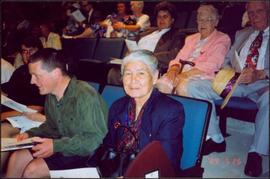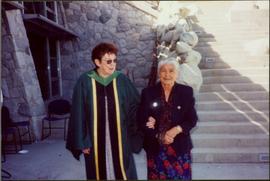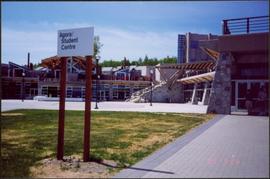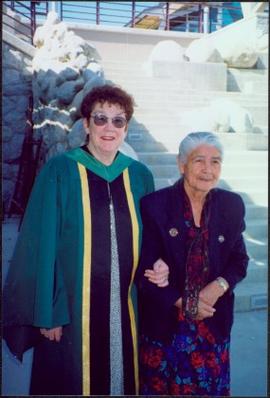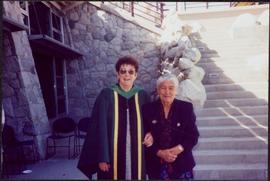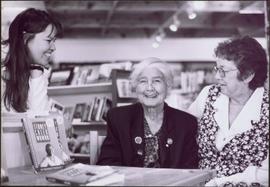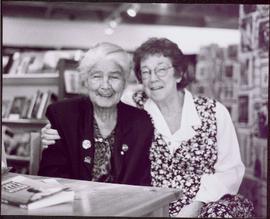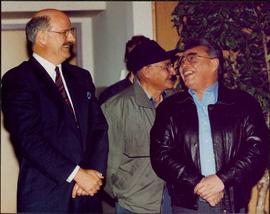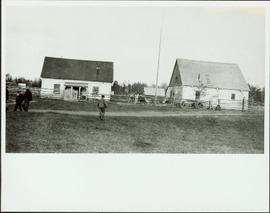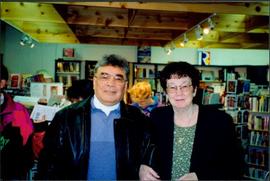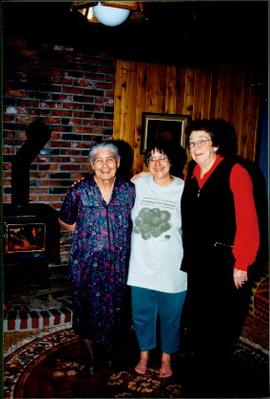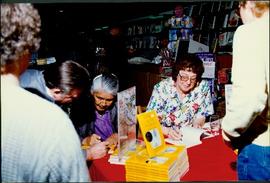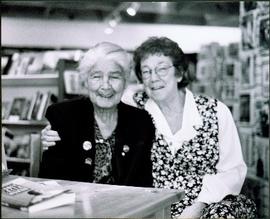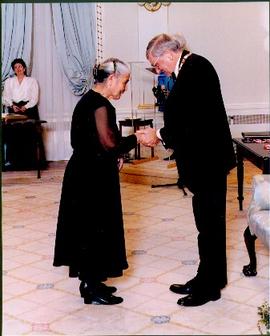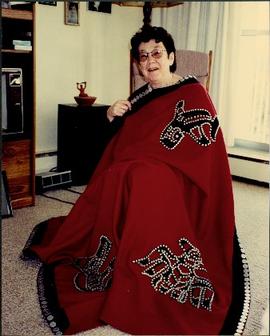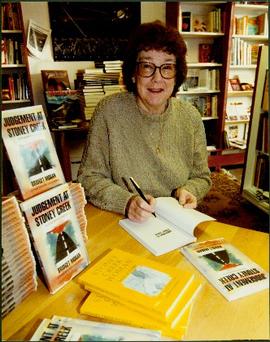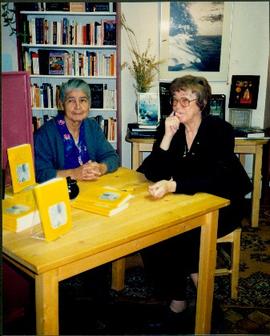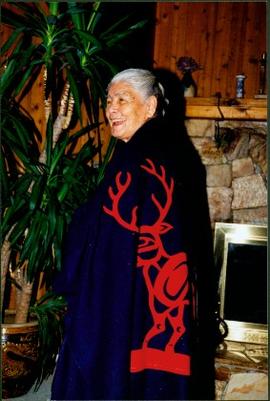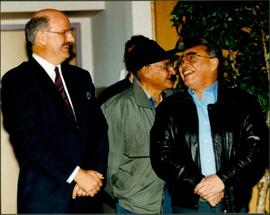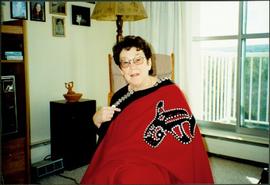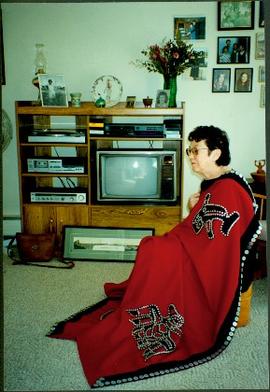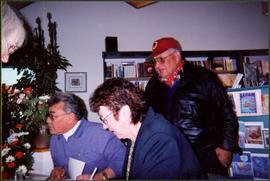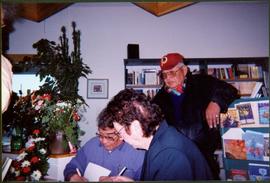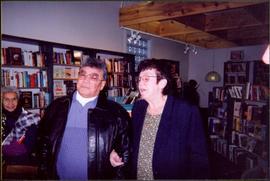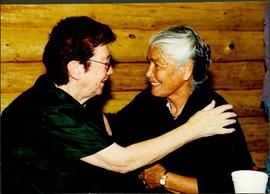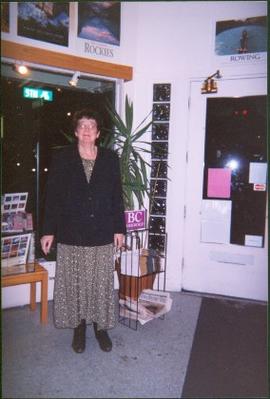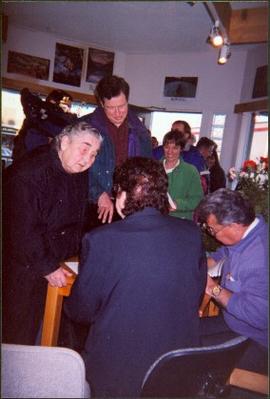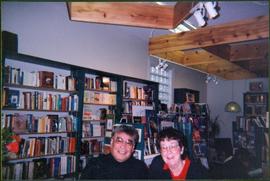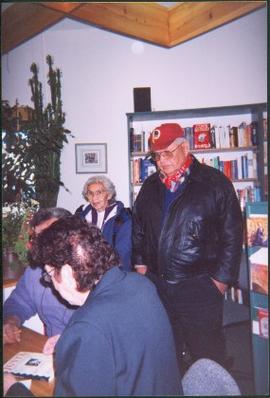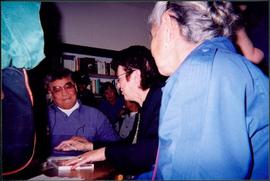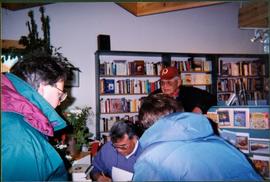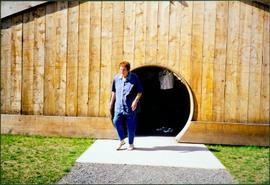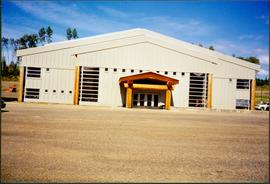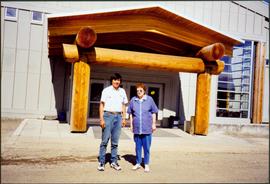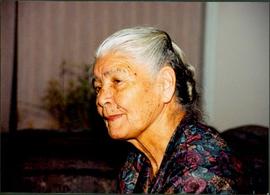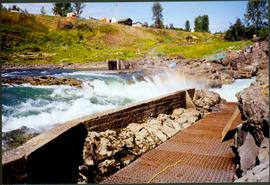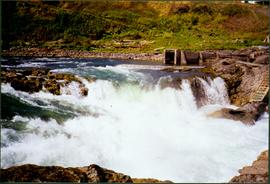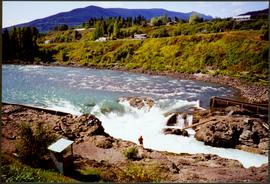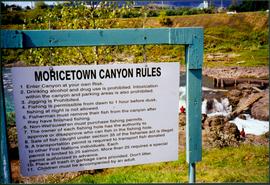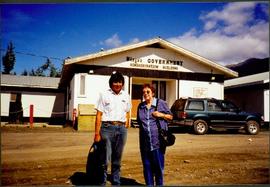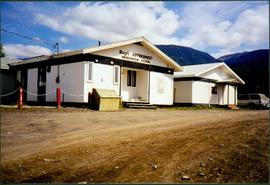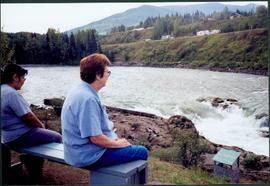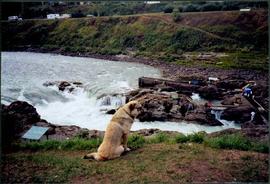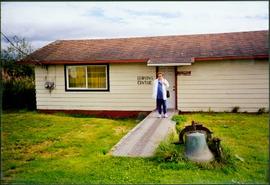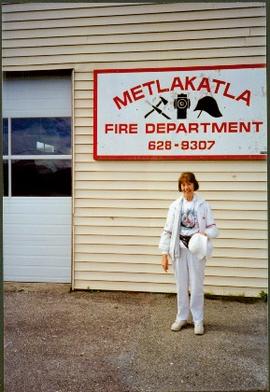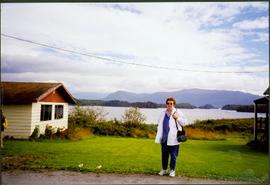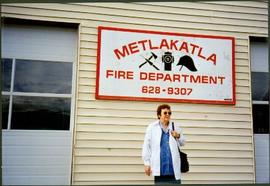Photograph depicts Mary John sitting next to aisle in Canfor Theatre at the University of Northern British Columbia in Prince George, B.C. Unidentified individuals seated in foreground and background. Accompanying note from Maureen Faulkner: "Mary John takes my seat." Photo taken on the day Bridget received an Honourary Law Degree, before ceremony began.
Photograph depicts Moran wearing regalia and linking arms with Mary John. Stone steps in background. The pair stands in the Agora courtyard at the University of Northern British Columbia in Prince George, B.C. Photo taken on the day Bridget Moran received an Honourary Law Degree.
Photograph depicts the Agora center at the University of Northern British Columbia in Prince George, B.C. Sign in foreground reads "Agora/Student Centre". Unidentified individuals can be seen in red blankets on upper walkway in background, above the Winter Garden. Accompanying note from Maureen Faulkner: "The first nations people, in button blankets, gather". Photo believed to have been taken on the day Bridget Moran received an Honourary Law Degree.
Photograph depicts Moran wearing regalia and linking arms with Mary John. Stone steps in background.
Photograph depicts Moran wearing regalia and linking arms with Mary John. Stone steps in background. The pair stands in the Agora courtyard at the University of Northern British Columbia in Prince George, B.C. Photo taken on the day Bridget Moran received an Honourary Law Degree.
Photograph depicts Moran seated to right of Mary John at table displaying copies of 'Stoney Creek Woman'. Unidentified woman stands on left, bookshelves can be seen in background.
Photograph depicts Moran with arm around Mary John, both seated at book display table. Bookshelves in background.
Photograph depicts Justa Monk standing to right of Premier Harcourt in unknown room. John Alexis can be seen between them in background. Handwritten annotation on recto of photograph: "Justa Monk / John Alexis Tachie Village / The Premier / Taken in Prince George, B.C. Jan 23/95 / 'The day Kemano 2 was killed'."
Photograph depicts two buildings behind fence, sheds visible in background. Unidentified men can be seen walking in foreground. Small structures believed to be teepees can be seen behind fence.
Justa Monk and Bridget Moran stand in foreground. Unidentified individuals can be seen in bookstore in background. Bridget Moran published a book in 1994 entitled 'Justa: A First Nations Leader, Dakelhne Butsowhudilhzulh'un'.
Unidentified woman stands between Mary John (on left) and Bridget Moran. Fireplace in background.
Photograph depicts Mary John seated to left of Bridget Moran at book signing table. Copies of 'STONE CREEK WOMAN' displayed in foreground. Three unidentified individuals stand gathered around table. Bookshelves and computer in background.
Photograph depicts Moran with arm around Mary John, both seated at book display table. Bookshelves in background.
Photograph depicts Mary John shaking hands with unidentified man at official ceremony where she was awarded the Order of Canada for outstanding service to her community. Two unidentified woman stand in background in large ornately furnished room.
Photograph depicts Moran seated in chair at unknown location. Red and black button blanket features traditional thunderbird, wolf, and killer whale designs. Television, armchair, and window visible in background.
Photograph depicts Bridget Moran seated at table covered with copies of 'Judgement at Stoney Creek'. Three copies of 'Stoney Creek Woman' are also displayed on table. Bookshelves in background. Photo believed to have been taken at same location as items 2008.3.1.17.1, 2008.3.1.17.2, and 2008.3.1.19.4.
Photograph depicts Mary John seated to left of Bridget Moran at book signing table. Copies of 'STONE CREEK WOMAN' displayed in foreground, plants and bookshelves in background.
Photograph depicts Mary John wearing long blue material with red caribou in traditional artwork on back. Plant and ornamented fireplace in background. Photo speculated to have been taken in Mary John's home.
Photograph depicts Justa Monk standing to right of Premier Harcourt in unknown room. John Alexis can be seen between them in background.
Photograph depicts Moran seated in chair at unknown location. Red and black button blanket features traditional thunderbird and killer whale designs. Television, armchair, and window visible in background.
Photograph depicts Moran seated in chair at unknown location. Red and black button blanket features traditional thunderbird and killer whale designs. Television against wall in background.
Photograph depicts Justa Monk and Bridget Moran seated at table, signing copies of 'Justa: a First Nations Leader'. Plants, bookshelves, two unidentified individuals also visible in image.
Photograph depicts Justa Monk and Bridget Moran seated at table, signing copies of 'Justa: a First Nations Leader'. Plants, bookshelves, and unidentified man visible in background.
Photograph depicts Justa Monk and Bridget Moran standing in bookstore. Unidentified woman and bookshelves in background.
Close view of Bridget Moran seated to left of Mary John, both with a hand on the other's shoulder. Log wall in background.
Photograph depicts Moran standing in bookstore. Window, door, and plants in background. Photo taken at book signing event for Moran's 'Justa: a First Nations Leader'.
Photograph depicts Justa Monk and Bridget Moran seated at table, signing copies of 'Justa: a First Nations Leader'. The pair faces crowd standing in background. Windows and posters visible behind crowd.
Photograph depicts Justa Monk and Bridget Moran seated in bookstore, bookshelves in background.
Photograph depicts Justa Monk and Bridget Moran seated at table, signing copies of 'Justa: a First Nations Leader'. Plants, bookshelves, and two unidentified individuals in background.
Photograph depicts Justa Monk and Bridget Moran seated at table, signing copies of 'Justa: a First Nations Leader'. Crowd stands gathered around.
Photograph depicts three unidentified individuals gathered around Justa Monk as he signs a copy of 'Justa: a First Nations Leader'. Plants and bookshelves in background.
Photograph depicts Moran walking away from round entrance to long house, unidentified individual visible inside.
Photograph depicts unidentified building with large wood beams in entryway.
Photograph depicts Moran standing with unknown man in front of building with large wood beams in entryway (see also item 2008.3.1.22.25 for image featuring Moran with this young man).
Close view of Mary John. Plant, couch, and window in background.
Photograph depicts fishing territory at waterfall rapids in Bulkley River, B.C. Highway and buildings on opposite shore in background.
Photograph depicts white rapids at bottom of waterfall in Bulkley River, B.C. Fishing territory visible on far right; hill on opposite shore in background.
Photograph depicts an unidentified individual standing on cliff above waterfall at Bulkley River, B.C. Fishing territory visible below; highway, buildings, and hills visible in background.
Photograph depicts sign in foreground outlining rules and restrictions for behaviour at Moricetown Canyon. Traditional fishing territory visible behind sign at waterfall in the Bulkley River, B.C. Highway and buildings can be seen in background.
Photograph depicts Bridget Moran standing beside unidentified man in front of white building with the sign "Nisga'a Government Administration building". Suburban parked in front of building, trees and mountains visible in background.
Photograph depicts two white buildings, one with the sign "Nisga'a Government Administration building". Road in foreground, vehicles and hills in background.
Photograph depicts Moran seated to right of woman on bench in foreground. Waterfall area at Moricetown Canyon can be seen below, behind booth labeled "MONITER BOOTH". Highway and houses visible on opposite shore in background.
Photograph depicts dog seated on grass in foreground. Unidentified individuals visible below with fishing nets in waterfall area at Moricetown Canyon.
Moran stands on sidewalk in front of building with signs reading "LEARNING CENTRE" and "ST. PAUL'S ANGLICAN CHURCH". Large iron bell sits in grass in foreground, forest in background. Photo believed to have been taken near Metlakatla Lake, B.C.
Woman stands in front of building with the sign "METLAKATLA FIRE DEPARTMENT 628-9307". Garage door visible on left.
Bridget Moran stands on road, unidentified buildings behind on either side. Lake and hills on opposite shore in background. Photo believed to be taken at Metlakatla Lake, B.C. Building on left speculated to be the St. Paul's Anglican Church Learning Centre.
Moran stands in front of building with the sign "METLAKATLA FIRE DEPARTMENT 628-9307".
Audio recording consists of an interview conducted by Bridget Moran with Mary John.
Audiocassette Summary
00’05” Bridget is interviewing Mary John who discusses a potlatch held at Stoney Creek that Bridget attended. Bridget asks about the talking stick and she asks Mary John to explain its significance. Mary explains there had been a naming ceremony about a year ago and that a woman named Maisie had changed clans from her mother to her father’s clan. Mary notes while this is unusual, her father’s only son had died and therefore requested that the daughter changed clans. At this ‘September potlatch’ therefore this woman had to change tables at the potlatch.
04’00” Mary explains the context of the September Potlatch. She notes that Maisie had hosted this potlatch to pay back for the gifts that had been provided for her from a year ago when she received a new name. They then discuss the amount of money that the host gave to the guests and the amount of money that is normally provided – there is no particular amount ‘whatever you wish’ Mary notes she had provided Maisie with a gift last year of $100 but that Maisie gave her back $200 – that is not required – there is no required amount
07’30” Mary explains that at a potlatch you are expected to bring a case or few bags of food
08’00” Mary discusses the type of food provided at a potlatch; it is traditional food not western food; Bridget notes there was caribou provided there. Mary explains that the host of a potlatch asks people to hunt for moose and deer meat in order to prepare for the food to be served. Bridget then talks about the food that was served and Mary notes it included also fish and beaver.
11’00” Bridget asks Mary to talk about the gifts given to her daughter Flo at the potlatch in exchange for a loan she provided to another woman whose husband had died a year before. Bridget notes it was a ‘touching’ moment.
12’00” Mary talks about the Priest ‘Father Brian’ who was at the potlatch. Four clans collected money and gave it to the priest for his work [missionary work?]
15’07” Mary explains the situation of Geraldine Thomas –that at the potlatch she was not seated before; that is she was not initiated before and so she was seated at the potlatch
15’57” Tape stops momentarily
16’09” Mary continues to talk about Geraldine and the potlatch events; the significance of the tapping of the talking stick; then she was seated and guests give her gifts. Then Mary talks about Ernie and her late daughter Helen who also wanted to cross their clan but that Mary ‘did not let her go’
20’00” Mary talks about the feelings of a child who gives up their clan and that it is like ‘giving up one of your children’ as Celina noted to Bridget at the event.
21’00” Mary talks about her son Ernie who crossed over to his father’s clan and that he was gifted at the potlatch
22’00” Bridget then notes that at this potlatch that the Frog Clan became host of the Grouse clan at this potlatch. Mary explains that the clan then had debts to pay at this potlatch.
26’00” Mary talks about the death of Stoney Creek members; she is unsure when there will be another potlatch in Stoney Creek.
28’00” Bridget notes that she did not understand the ceremony as it was in Carrier language; however Bridget notes it is a pity the white world doesn’t see potlatches as they are ‘so touching’
31’00” Mary explains that each clan takes care of the deceased family members and takes care of putting up the headstone
32’00” Tape ends abruptly
Audio recording consists of an interview conducted by Bridget Moran with Mary John.
Audiocassette Summary
Scope and Content: Tape consists of a recording of Bridget interviewing Mary John primarily about her visit to the former native village site of Cheslatta
Side 1
Interview in process
00’05” Bridget interviews Mary John, Mary is referring to Madeline her niece.
1’00” Bridget asks Mary what made her decide to go to Cheslatta – to see the site where she had lived. Bridget asks if it was a ‘rediscovery’ trip. Bridget asks if this is where the village was burned out and flooded out [by Kemano development] Mary talks about her son Ernie wanting to go there and create a territorial hunting ground. She talks about going there with her niece Madeline and Alex
8’40” Mary explains how they got to Cheslatta; the travel there was by van through Francois Lake and via logging roads; it took about hour and half drive
11’00” Mary explains it was not the village that had been flooded that they went to; not the original village; she notes there was a campsite set up for them but it was cold at night. There were people there from Stellaco, about 75 total. She describes making bannock on a stick over the fire ‘the real bannock’ for the youth – like an “Indian pizza” (she laughs)
16’00” Mary continues to talk about the activities that she did at Cheslatta; show the youth how to fish, spear fish, clean fish, cut in strips and smoke the fish. There was no smokehouse but they created a lean- to and smoked the fish. Mary also notes another day Mary and Madeline took the youth to the bush and talked to them about uses of trees –
22’00”-20’25” Mary describes the steps involved with showing the youth at the Cheslatta camp how to collect spruce in order to build a smoke house for smoking the fish
29’30” Mary discusses food that she prepared for the gathering for the people
31’00” Mary talks about the group visiting the old village Cheslatta after the gathering
Mary then leaves to attend to a crying baby [a great-grand-child?]; they greet the mother
33’00” Bridget refers to a group of kids she talked to at Kamloops about their book Stoney Creek Woman. Bridget tells Mary she has letters written to Mary John by several students who had read Bridget’s book that she wants to show her
36’00” They continue to talk about the former Cheslatta village and what the former village residents want to do about the village; Mary notes there are archaeologists working there. Mary states the people have not yet received compensation for being taken off their land. Bridget notes those people loss their sense of community
38’31” Mary remarks the people at Cheslatta “have a good chief” “very humble person”
39’40” Bridget asks Mary about the Lejac pilgrimage. Mary then talks about the pilgrimage that is held at Lejac and that she had just been there ‘on Sunday night’; she notes it is arranged by Celina; she notes there were Tache people there. Bridget asks if there are children buried at Lejac and Mary notes there are children and students buried there – about 15 to 20 buried there.
43’00” They briefly discuss if this was a rediscovery for the Cheslatta people at the event. Mary agrees; she notes she stayed there for 10 days; Bridget remarks it was similar to Mary’s former camp of what she had experienced at Wedgewood. They talk about Mary’s son Ernie and that he has in Bridget’s view ‘leadership qualities”
45’30” Bridget asks about getting a bannock recipe for a Senior’s cookbook. Mary begins to tell the recipe
Side 2
47’40” Mary continues to show Bridget how to make bannock
50’00” Mary briefly refers to the event at Cheslatta again
End of tape
Audio recording consists of an interview conducted by Bridget Moran with Mary John.
Audiocassette Summary
Context: Tape recording is an interview between Bridget and Mary John in which Bridget initially asks Mary John about events after the inquest into Coreen Thomas’s death. Bridget notes also that she wants to provide an update on Mary John’s life 10 years after the inquest.
Side 1
00’05” Bridget asks Mary John about her role in the Coreen Thomas inquest. Mary thinks that she discovered Coreen’s death due to the ringing of the church bells [to announce a death]. She tries to recall the series of events leading up to her time being involved in getting an inquest. Recalls Sophie Thomas’ desire to have an inquest into her death
6’00” -10’00” She recalls that the [Indian] Homemakers Association became involved in attempting to get an inquest. She says ‘she was just tagging along with it …I was not a fighter” Bridget notes that Harry Rankin stayed at Helen’s house when he represented the Homemakers Association at the inquest. Bridget recalls the ‘marvellous’ dinner that was put on for them at the time of the inquest by Mary John and Helen. Mary John notes it was at the invitation of the Homemakers Association for the group to come to her house.
10’:00”-14’00” Bridget and Mary talk about follow-up to the inquest and Coreen’s family.
14’50”- 25’00” Mary talks about her involvement as well as others in the creation of the Elders Society after the death of Mary’s son due to drowning in 1978. The Society had workshops in an effort to revive their culture with the hope of having the younger generations take pride in their culture. One of the activities was the building of the Potlatch House in 1980 where they did traditional activities including tanning of hides.Talks about acquiring the land to build the potlatch house and having the Chief take care of getting the land from BCR; the Society cleared the land twice over to set up the house. Mary explains that the Society acquired funding of $93,000.00 from ARDA [?] to clear the land from the logs and build the house.
26’00”-30’00” Mary talks about a new project that the Society has to build 10 rental tourist cabins as a business for the youth to operate. Bridget suggests it could be similar to that at K’san. Mary also explains that there is a cook-house at the Potlatch House as well and that it has been used for community events, weddings, dinners, organizational events also.
Tape stops momentarily and starts again
30’05”- 36’00” Mary talks about the drowning of her son and finding of his body in 1978 as well as other tragedies that happened in the community which led to the creation of the Elders Society to assist the youth
36’30” -39’30” Mary talks about the joys of finally having her own house and the building of the house
39’32” -42’40” Mary talks about the organizations that she is involved in now. She talks about a film made in the community about social workers coming in the community to work with Elders to care for issues related to youth. She notes that ‘that’s when the ice broke’ and it made a difference.
43’00” She talks about a dinner that she holds every year for the police officers to thank them for the service they do for society
43’30” Talks about fishing at Fraser Lake
44’00” -46’00” Mary talks about her work now at her house to teach the youth about their culture: making of baskets, moccasins, tanning of hides
End of side 1
Side 2
46’30”-48’00” Mary continues to talk about the activities that she does with native youth to educate them about their culture
48’50” Bridget asks about whether the youth are involved in tree-planting and asks another woman in the room (Bernice?)
50’00” – 56’00” Bridget asks what her three wishes are for her people: better lives; more education for the young people to have better jobs; they need to get out to the white world and not be so isolated; she refers to when she worked in ‘the white world’ She talks about the isolation of the reserve and yet the protection that it offers to the people as well. Bridget and Mary talk about the reserve offering a way to protect the native culture. Bridget asks why it is important to protect their culture. Mary notes their culture is so important; she notes that other cultures like Japan and China haven’t lost their culture so why should the natives.
56’05” Mary notes that none of the grandchildren speak Carrier and the need to protect their culture and language when being surrounded by a white community. Refers to her grandson Fabian who is in the room
57’00” Bridget recalls a Fort St. James woman who tried to keep native kids out of white schools. She wanted them to be kept on the reserve so that they didn’t lose their culture. She talks about the fight by many to get their native status back – those whose one parent is not native
58’00” Mary talks about her worries for the young native people in the community who fear they have no future and who have no employment or education.
End of tape
